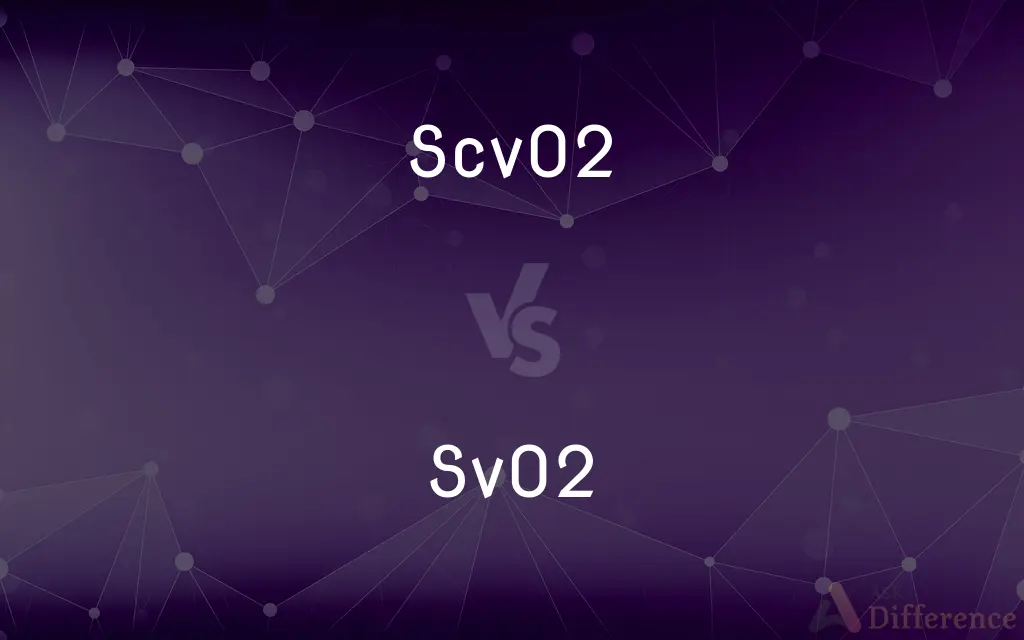ScvO2 vs. SvO2 — What's the Difference?
By Tayyaba Rehman & Fiza Rafique — Published on February 4, 2024
ScvO2 is oxygen saturation in central venous blood, indicating upper body oxygenation; SvO2 is oxygen saturation in mixed venous blood, reflecting whole body oxygenation.

Difference Between ScvO2 and SvO2
Table of Contents
ADVERTISEMENT
Key Differences
ScvO2 (Central Venous Oxygen Saturation) measures the oxygen saturation level in the blood from the central veins, specifically reflecting oxygen use by the upper body, including the brain and heart. SvO2 (Mixed Venous Oxygen Saturation), however, measures the oxygen saturation level in the blood from the pulmonary artery, providing an assessment of overall body oxygenation and consumption.
ScvO2 is typically obtained through a catheter placed in a large central vein, such as the superior vena cava, and is used to gauge the balance between oxygen delivery and consumption in critical care settings. SvO2, on the other hand, requires sampling from the pulmonary artery, usually via a pulmonary artery catheter, offering a more comprehensive view of the body's oxygen utilization.
While ScvO2 provides valuable insights into the oxygenation status of the upper part of the body and can be a useful indicator of cerebral and coronary oxygenation, it may not always reflect the oxygenation status of other tissues or the lower body. SvO2 encompasses a broader assessment, including blood from both the upper and lower body, thus giving a more global picture of oxygen balance.
The interpretation of ScvO2 and SvO2 values can guide therapeutic interventions in critically ill patients, with both measurements used to optimize oxygen delivery and consumption. However, the choice between ScvO2 and SvO2 monitoring depends on the clinical context, the patient's condition, and the specific information required by the healthcare team.
Differences in ScvO2 and SvO2 readings can indicate variations in oxygen use between the body's regions, with lower values suggesting increased oxygen extraction due to higher metabolic demands or inadequate oxygen delivery. Monitoring trends in ScvO2 and SvO2 can be crucial for managing patients with conditions like sepsis, heart failure, and major surgery.
ADVERTISEMENT
Comparison Chart
Measurement Site
Central veins (e.g., superior vena cava)
Pulmonary artery
Reflects Oxygenation of
Upper body (brain, heart)
Whole body
Typical Use
Assessing cerebral and coronary oxygenation
Assessing overall oxygen balance
Sampling Method
Central venous catheter
Pulmonary artery catheter
Indicative of
Localized oxygen use and delivery
Global oxygen use and delivery
Compare with Definitions
ScvO2
Reflects balance between oxygen delivery and consumption in the upper body.
An increasing ScvO2 trend suggests improved oxygenation status post-intervention.
SvO2
Indicator of global oxygen utilization.
SvO2 monitoring helps in assessing the adequacy of tissue oxygenation.
ScvO2
Indicator of upper body oxygenation.
ScvO2 monitoring is critical for patients with suspected cerebral hypoxia.
SvO2
Essential for managing complex cardiac cases.
In heart failure management, SvO2 values guide therapeutic decisions.
ScvO2
Measured via central venous catheter.
The central line was placed for continuous ScvO2 measurement in the ICU patient.
SvO2
Oxygen saturation in mixed venous blood.
SvO2 is a key parameter in evaluating the patient's overall oxygenation status.
ScvO2
Oxygen saturation in the central venous blood.
A low ScvO2 reading may indicate inadequate oxygen delivery to the brain and heart.
SvO2
Reflects whole-body oxygen balance.
A decline in SvO2 may indicate systemic hypoxemia or increased oxygen demand.
ScvO2
Used in critical care to guide oxygen therapy.
Adjustments to the patient's ventilator settings were based on ScvO2 values.
SvO2
Obtained from the pulmonary artery.
The pulmonary artery catheter provided continuous SvO2 readings during surgery.
Common Curiosities
What does SvO2 indicate?
SvO2 indicates the oxygen saturation in mixed venous blood, reflecting the overall balance between oxygen delivery and consumption in the body.
What does a high ScvO2 value indicate?
A high ScvO2 may suggest that the body is receiving more oxygen than it needs, possibly due to decreased oxygen consumption.
What is SvO2?
SvO2 stands for Mixed Venous Oxygen Saturation, which measures the oxygen saturation level in blood returning to the heart after circulating through the body's tissues.
How is SvO2 measured?
SvO2 is measured using a specialized catheter inserted into the pulmonary artery or through non-invasive methods like pulse oximetry.
What does a low ScvO2 value indicate?
A low ScvO2 can indicate insufficient oxygen delivery to tissues and may suggest conditions like shock or poor cardiac output.
How is ScvO2 obtained?
ScvO2 is obtained through a catheter placed in a central vein, such as the superior vena cava.
What is the normal SvO2 range?
The normal SvO2 range is typically between 60% to 80%.
When is SvO2 more informative than ScvO2?
SvO2 is preferred when precise assessment of global oxygen delivery and utilization is needed, as it reflects the entire body's oxygen dynamics.
What does ScvO2 measure?
ScvO2 measures the oxygen saturation in the central venous blood, indicating upper body oxygen utilization.
Why are ScvO2 and SvO2 important in critical care medicine?
They provide crucial information about tissue oxygenation and guide treatment decisions in critically ill patients.
What does a high SvO2 value indicate?
A high SvO2 may suggest that oxygen is not being effectively utilized by the body's tissues, possibly due to reduced metabolic demand.
What are the key differences between ScvO2 and SvO2?
ScvO2 measures oxygen saturation in blood returning from the upper body, while SvO2 measures oxygen saturation in blood returning from all body tissues.
When is ScvO2 preferred over SvO2 in clinical practice?
ScvO2 is often used when measuring SvO2 is impractical or risky, as it provides a reasonable estimate of overall oxygenation.
What interventions can be guided by ScvO2 and SvO2 values?
ScvO2 and SvO2 values can help guide interventions such as fluid administration, oxygen therapy, and vasopressor use to optimize tissue oxygenation in critically ill patients.
What does a low SvO2 value indicate?
A low SvO2 can indicate oxygen extraction by tissues is increased, often seen in conditions like sepsis or severe cardiac dysfunction.
Share Your Discovery

Previous Comparison
People’s Republic Of China vs. Republic Of China
Next Comparison
Navratri vs. DussehraAuthor Spotlight
Written by
Tayyaba RehmanTayyaba Rehman is a distinguished writer, currently serving as a primary contributor to askdifference.com. As a researcher in semantics and etymology, Tayyaba's passion for the complexity of languages and their distinctions has found a perfect home on the platform. Tayyaba delves into the intricacies of language, distinguishing between commonly confused words and phrases, thereby providing clarity for readers worldwide.
Co-written by
Fiza RafiqueFiza Rafique is a skilled content writer at AskDifference.com, where she meticulously refines and enhances written pieces. Drawing from her vast editorial expertise, Fiza ensures clarity, accuracy, and precision in every article. Passionate about language, she continually seeks to elevate the quality of content for readers worldwide.
















































